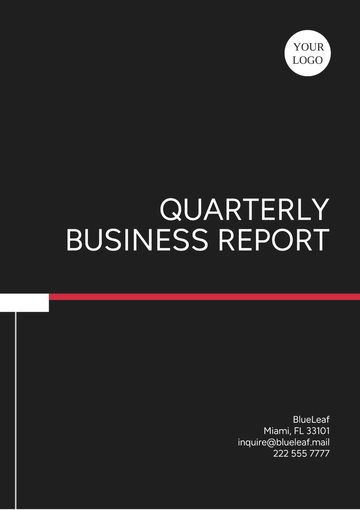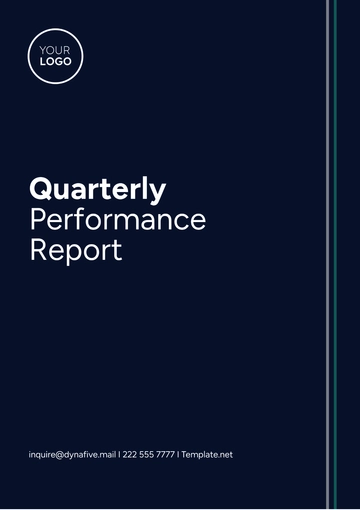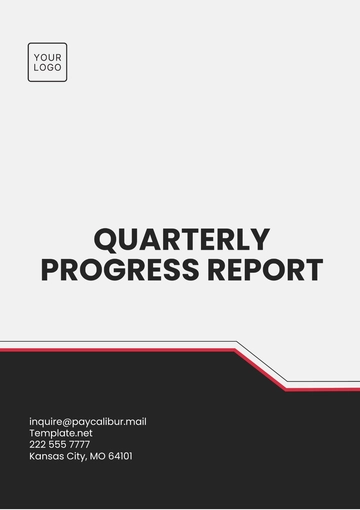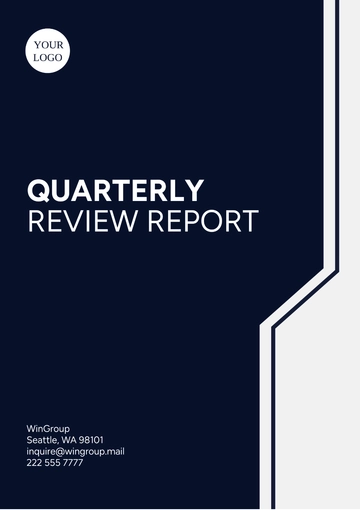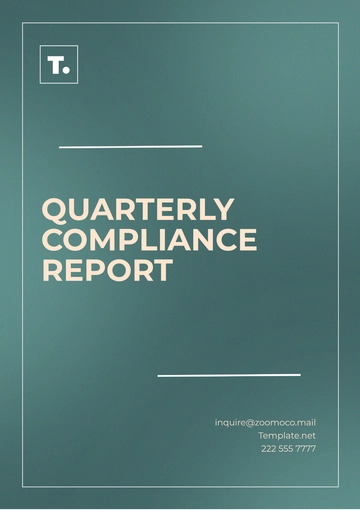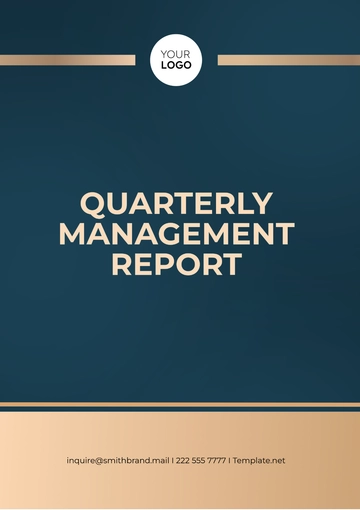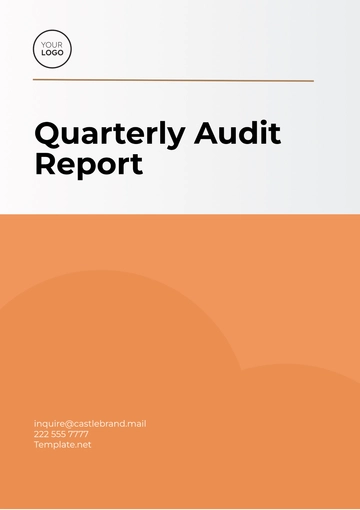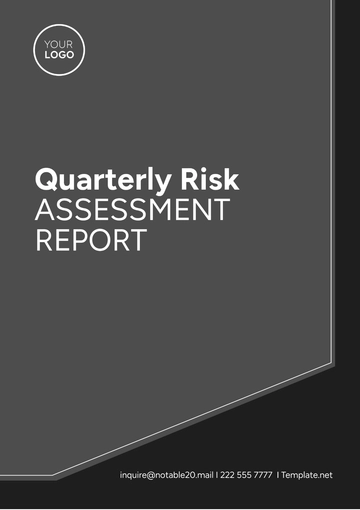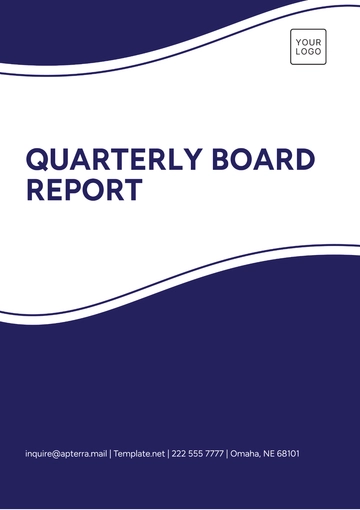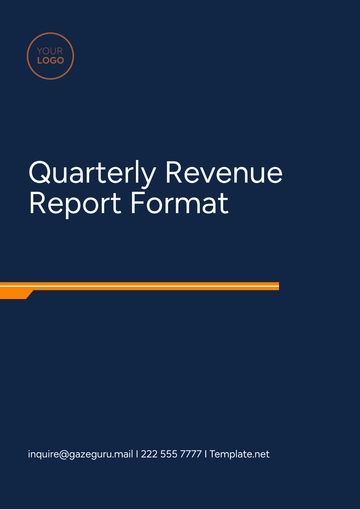Free Product Sales Quarterly Report

Prepared by: [Your Name]
I. Executive Summary
As the Sales Team of [Your Company Name], we are pleased to present the Q2 2054 Product Sales Quarterly Report. This report provides a comprehensive overview of our sales performance and strategic insights for the quarter. It aims to guide our next steps in achieving our revenue targets and adapting to market dynamics.
II. Sales Performance Metrics
A. Overview
In Q2 2054, [Your Company Name] achieved a total revenue of $5.2 million, reflecting a steady growth trajectory compared to $4.8 million in Q2 2053. While we did not meet our revenue target of $5.5 million, the 8% year-over-year growth in revenue highlights our resilience in a competitive market.
B. Detailed Metrics
Metric | Q2 2054 Actual | Q2 2053 Actual | Q2 2054 Target |
|---|---|---|---|
Total Revenue | $5,200,000 | $4,800,000 | $5,500,000 |
Units Sold | 25,000 | 22,500 | 26,000 |
Average Selling Price | $208 | $213 | $212 |
Our units sold increased to 25,000, up from 22,500 in Q2 2053, indicating strong demand for our products. The average selling price decreased slightly to $208, reflecting our strategic pricing adjustments aimed at capturing market share and stimulating sales volume.
III. Product Performance Analysis
A. Category Breakdown
Product Category | Q2 2054 Sales ($USD) | Q2 2053 Sales ($USD) | Q2 2054 Units Sold | Q2 2053 Units Sold |
|---|---|---|---|---|
Electronics | $2,500,000 | $2,200,000 | 12,000 | 10,500 |
Apparel | $1,200,000 | $1,000,000 | 6,000 | 5,500 |
Home Goods | $1,500,000 | $1,600,000 | 6,000 | 6,500 |
Electronics remained our top-performing category with sales reaching $2.5 million, up from $2.2 million in Q2 2053. Apparel and home goods also saw growth, contributing $1.2 million and $1.5 million respectively. The increase in units sold across all categories reflects effective sales strategies and market responsiveness.
IV. Trends and Insights
A. Seasonal Variations
We observed a seasonal peak in sales during the summer months, driven by increased consumer spending on outdoor and leisure products. However, winter sales showed a slight decline in home goods, which we attribute to cautious consumer behavior amidst economic uncertainties.
B. Pricing Strategy Impact
Our strategic decision to adjust prices in Q2 2054 resulted in a notable 10% increase in unit sales across key product lines. This approach not only enhanced our competitive position but also supported revenue growth despite a slight decrease in average selling price.
C. Online Sales Growth
Our online sales surged by 20% compared to Q2 2053, marking a significant achievement driven by targeted digital marketing campaigns and improved user experience on our e-commerce platforms. This growth underscores the importance of our digital strategy in reaching and engaging customers effectively.
V. Comparison to Targets
A. Performance Analysis
Metric | Q2 2054 Actual | Q2 2054 Target | Variance |
|---|---|---|---|
Total Revenue | $5,200,000 | $5,500,000 | -$300,000 |
Units Sold | 25,000 | 26,000 | -1,000 |
Average Selling Price | $208 | $212 | -$4 |
While we fell short of our revenue target by $300,000, our performance in units sold was only 1,000 units below the target of 26,000. The slight decrease in average selling price by $4 was a deliberate strategy to drive higher sales volume, demonstrating our flexibility in responding to market conditions.
VI. Key Challenges and Opportunities
A. Market Competition
The competitive landscape intensified in Q2, with new entrants offering innovative products and aggressive pricing strategies. To maintain our market position, [Your Company Name] needs to differentiate itself through superior customer service and product innovation.
B. Supply Chain Constraints
Challenges in the supply chain, such as delays in product availability and increased logistics costs, impacted our operational efficiency. Addressing these issues requires closer collaboration with suppliers and exploring alternative sourcing solutions to ensure uninterrupted supply to meet customer demand.
C. Emerging Markets
Exploring opportunities in emerging markets, particularly in Asia-Pacific and Latin America, presents significant growth potential for [Your Company Name] However, penetrating these markets effectively requires localized marketing strategies and adapting our product offerings to meet diverse consumer preferences.
VII. Recommendations
A. Pricing Strategy Adjustment
We recommend fine-tuning our pricing strategy to optimize profitability while remaining competitive in the market. This includes conducting regular pricing analyses to align with consumer perceptions of value and adjust prices dynamically based on market trends.
B. Enhanced Marketing Campaigns
Investing in enhanced digital marketing campaigns, including personalized promotions and targeted advertising, will be crucial to sustaining [Your Company Name] online sales growth momentum. Leveraging data analytics to understand customer behavior and preferences will help us craft more impactful marketing messages and improve customer engagement.
C. Streamline Supply Chain Operations
To mitigate supply chain risks and enhance operational efficiency, we propose streamlining our supply chain processes. This involves leveraging technology for real-time inventory management, optimizing distribution networks, and establishing strategic partnerships with reliable suppliers to improve lead times and reduce costs.
- 100% Customizable, free editor
- Access 1 Million+ Templates, photo’s & graphics
- Download or share as a template
- Click and replace photos, graphics, text, backgrounds
- Resize, crop, AI write & more
- Access advanced editor
Discover efficiency with the Product Sales Quarterly Report Template from Template.net. This editable and customizable template streamlines your reporting process effortlessly. Tailor data effortlessly with our Ai Editor Tool, ensuring your quarterly insights are both precise and visually compelling. Streamline your reporting today and elevate your business strategy with ease.
You may also like
- Sales Report
- Daily Report
- Project Report
- Business Report
- Weekly Report
- Incident Report
- Annual Report
- Report Layout
- Report Design
- Progress Report
- Marketing Report
- Company Report
- Monthly Report
- Audit Report
- Status Report
- School Report
- Reports Hr
- Management Report
- Project Status Report
- Handover Report
- Health And Safety Report
- Restaurant Report
- Construction Report
- Research Report
- Evaluation Report
- Investigation Report
- Employee Report
- Advertising Report
- Weekly Status Report
- Project Management Report
- Finance Report
- Service Report
- Technical Report
- Meeting Report
- Quarterly Report
- Inspection Report
- Medical Report
- Test Report
- Summary Report
- Inventory Report
- Valuation Report
- Operations Report
- Payroll Report
- Training Report
- Job Report
- Case Report
- Performance Report
- Board Report
- Internal Audit Report
- Student Report
- Monthly Management Report
- Small Business Report
- Accident Report
- Call Center Report
- Activity Report
- IT and Software Report
- Internship Report
- Visit Report
- Product Report
- Book Report
- Property Report
- Recruitment Report
- University Report
- Event Report
- SEO Report
- Conference Report
- Narrative Report
- Nursing Home Report
- Preschool Report
- Call Report
- Customer Report
- Employee Incident Report
- Accomplishment Report
- Social Media Report
- Work From Home Report
- Security Report
- Damage Report
- Quality Report
- Internal Report
- Nurse Report
- Real Estate Report
- Hotel Report
- Equipment Report
- Credit Report
- Field Report
- Non Profit Report
- Maintenance Report
- News Report
- Survey Report
- Executive Report
- Law Firm Report
- Advertising Agency Report
- Interior Design Report
- Travel Agency Report
- Stock Report
- Salon Report
- Bug Report
- Workplace Report
- Action Report
- Investor Report
- Cleaning Services Report
- Consulting Report
- Freelancer Report
- Site Visit Report
- Trip Report
- Classroom Observation Report
- Vehicle Report
- Final Report
- Software Report


